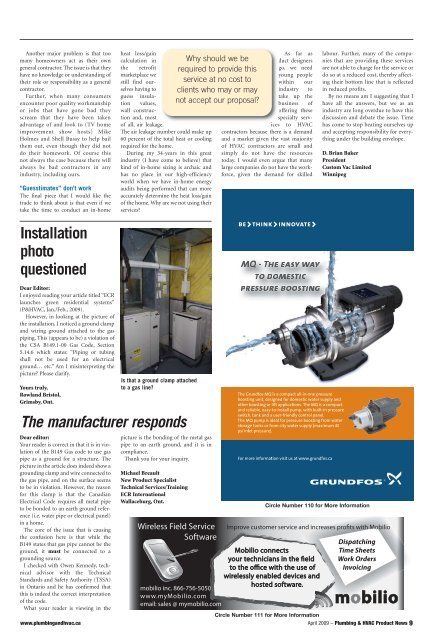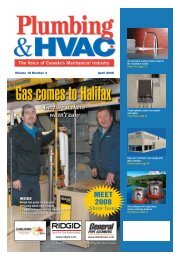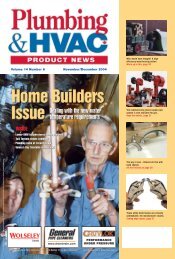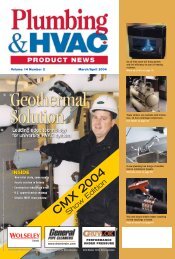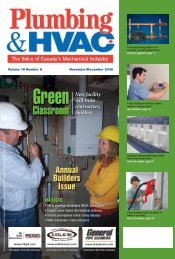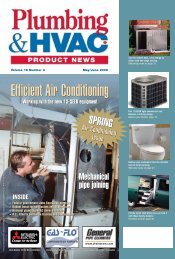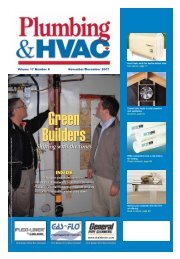phvac Dec 2006.qxd - Plumbing & HVAC
phvac Dec 2006.qxd - Plumbing & HVAC
phvac Dec 2006.qxd - Plumbing & HVAC
Create successful ePaper yourself
Turn your PDF publications into a flip-book with our unique Google optimized e-Paper software.
Another major problem is that too<br />
many homeowners act as their own<br />
general contractor. The issue is that they<br />
have no knowledge or understanding of<br />
their role or responsibility as a general<br />
contractor.<br />
Further, when many consumers<br />
encounter poor quality workmanship<br />
or jobs that have gone bad they<br />
scream that they have been taken<br />
advantage of and look to (TV home<br />
improvement show hosts) Mike<br />
Holmes and Shell Bussy to help bail<br />
them out, even though they did not<br />
do their homework. Of course this<br />
not always the case because there will<br />
always be bad contractors in any<br />
industry, including ours.<br />
“Guesstimates” don’t work<br />
The final piece that I would like the<br />
trade to think about is that even if we<br />
take the time to conduct an in-home<br />
Installation<br />
photo<br />
questioned<br />
heat loss/gain<br />
calculation in<br />
the retrofit<br />
marketplace we<br />
still find ourselves<br />
having to<br />
guess insulation<br />
values,<br />
wall construction<br />
and, most<br />
of all, air leakage.<br />
The air leakage number could make up<br />
60 percent of the total heat or cooling<br />
required for the home.<br />
During my 34-years in this great<br />
industry (I have come to believe) that<br />
kind of in-home sizing is archaic and<br />
has no place in our high-efficiency<br />
world when we have in-home energy<br />
audits being performed that can more<br />
accurately determine the heat loss/gain<br />
of the home. Why are we not using their<br />
services?<br />
Why should we be<br />
required to provide this<br />
service at no cost to<br />
clients who may or may<br />
not accept our proposal?<br />
As far as<br />
duct designers<br />
go, we need<br />
young people<br />
within our<br />
industry to<br />
take up the<br />
business of<br />
offering these<br />
specialty services<br />
to <strong>HVAC</strong><br />
contractors because there is a demand<br />
and a market given the vast majority<br />
of <strong>HVAC</strong> contractors are small and<br />
simply do not have the resources<br />
today. I would even argue that many<br />
large companies do not have the workforce,<br />
given the demand for skilled<br />
labour. Further, many of the companies<br />
that are providing these services<br />
are not able to charge for the service or<br />
do so at a reduced cost, thereby affecting<br />
their bottom line that is reflected<br />
in reduced profits.<br />
By no means am I suggesting that I<br />
have all the answers, but we as an<br />
industry are long overdue to have this<br />
discussion and debate the issue. Time<br />
has come to stop beating ourselves up<br />
and accepting responsibility for everything<br />
under the building envelope.<br />
D. Brian Baker<br />
President<br />
Custom Vac Limited<br />
Winnipeg<br />
Dear Editor:<br />
I enjoyed reading your article titled “ECR<br />
launches green residential systems”<br />
(P&<strong>HVAC</strong>, Jan./Feb., 2009).<br />
However, in looking at the picture of<br />
the installation, I noticed a ground clamp<br />
and wiring ground attached to the gas<br />
piping. This (appears to be) a violation of<br />
the CSA B149.1-00 Gas Code, Section<br />
5.14.6 which states: “Piping or tubing<br />
shall not be used for an electrical<br />
ground… etc.” Am I misinterpreting the<br />
picture? Please clarify.<br />
Yours truly,<br />
Rowland Bristol,<br />
Grimsby, Ont.<br />
Is that a ground clamp attached<br />
to a gas line?<br />
The manufacturer responds<br />
Dear editor:<br />
picture is the bonding of the metal gas<br />
Your reader is correct in that it is in violation<br />
pipe to an earth ground, and it is in<br />
of the B149 Gas code to use gas compliance.<br />
pipe as a ground for a structure. The Thank you for your inquiry.<br />
picture in the article does indeed show a<br />
grounding clamp and wire connected to Michael Breault<br />
the gas pipe, and on the surface seems New Product Specialist<br />
to be in violation. However, the reason Technical Services/Training<br />
for this clamp is that the Canadian ECR International<br />
Electrical Code requires all metal pipe Wallaceburg, Ont.<br />
to be bonded to an earth ground reference<br />
Circle Number 110 for More Information<br />
(i.e. water pipe or electrical panel)<br />
in a home.<br />
The core of the issue that is causing<br />
Wireless Field Service Improve customer service and increases profits with Mobilio<br />
the confusion here is that while the<br />
Software<br />
B149 states that gas pipe cannot be the<br />
Dispatching<br />
ground, it must be connected to a<br />
Mobilio connects<br />
Time Sheets<br />
grounding source.<br />
your technicians in the field<br />
Work Orders<br />
I checked with Owen Kennedy, tech-<br />
to the office with the use of<br />
Invoicing<br />
nical advisor with the Technical<br />
wirelessly enabled devices and<br />
Standards and Safety Authority (TSSA)<br />
in Ontario and he has confirmed that<br />
hosted software.<br />
mobilio inc. 866-756-5050<br />
this is indeed the correct interpretation<br />
www.myMobilio.com<br />
of the code.<br />
email: sales @ mymobilio.com<br />
mobilio<br />
What your reader is viewing in the<br />
Circle Number 111 for More Information<br />
www.plumbingandhvac.ca April 2009 – <strong>Plumbing</strong> & <strong>HVAC</strong> Product News 9


